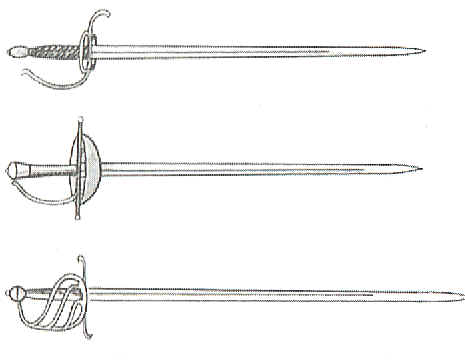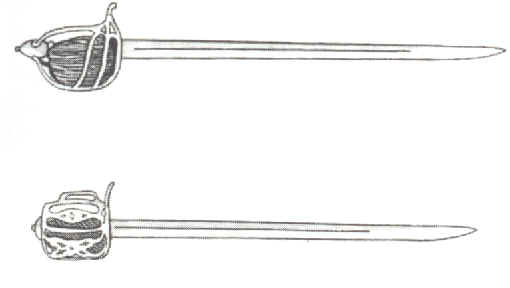
Swords
Many designs of swords appeared during the 17th century, partly due to the amount of fighting which took place at that time.
The basic soldiers sword was the Pike-man's Tuck, very similar to those used by seamen of the time, called a Hanger. Basically, these were robust 'slashing' blades which could cause more injury that way than by a thrust at the enemy.
The medieval sword with a straight 'Quillion' or cross-piece hilt, was a rare sight in the 17th century, though many swords still incorporated the quillion into the design of the hilt. It became more an item of decoration than of purpose.
However the soldier needed far more protection to his hand than the quillion alone could give. Many swords therefore, were fitted with a 'Knuckle-bow', simply an arch of metal to shield the fingers, fitted from the hilt to the 'Pommel' (the heavy ball fitted to the top of a sword to counterbalance the weight of the blade).
The Tuck was a type of short sword carried by a pike-man, much like the hanger carried by seamen of the time, having a knuckle-bow and a scallop guard at the hilt.
Many other designs appeared in the seventeenth century and a sword was the soldiers last means of defence. The sword was usually carried in a scabbard hanging from a baldrick, the diagonal leather belt that hangs from the right shoulder, with straps or loops at the bottom to secure the scabbard.
The cavalry-soldier's sword often had a blade 33-inches long or more, to enable the soldier to reach the enemy when he was riding on horse-back.
These swords were favoured for both cut and thrust, many designs evolving during the 17th century including half-basket-hilt, swept-hilt and twist-hilt to name but a few. The Full-basket-hilt gave much better hand protection, but was difficult to thrust.
 The
Tuck, with a single quillion and knuckle-bow. The hilt here is made
of two hoops of metal.
The
Tuck, with a single quillion and knuckle-bow. The hilt here is made
of two hoops of metal.
The Cup-hilt Rapier, with double quillions and a knuckle-bow behind a steel cup, often used on fencing swords today.
The Half-basket hilt has double quillions and protection for the back of the hand.
Lighter versions and some having cup-hilts were favoured during the Renaissance, by gentlemen of nobility and became the fencing swords for duels and sport.
In addition to a sword, a fixed blade knife called a dagger was often carried for protection by soldiers and civilians alike. Used in conjunction with a sword, it made a soldier a dangerous opponent during hand-to-hand combat.
This kind of knife was also very commonly used for eating meals before the refinement of forks arrived from Italy.
 This
Dragoons sword has a full basket-hilt and liner to protect the hand.
This
Dragoons sword has a full basket-hilt and liner to protect the hand.
The Scottish full basket-hilt with liner. In use 17th and 18th century.